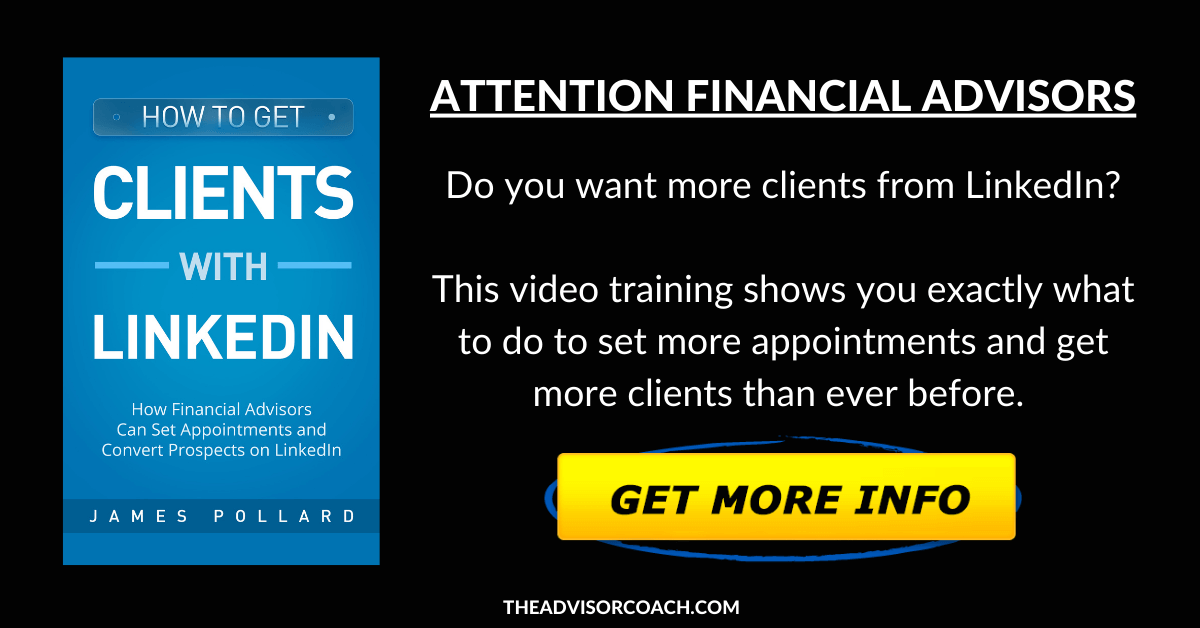5 Client Loyalty Strategies to Help You Retain More ClientsI am proudly known as the guy who helps financial advisors get more clients. I’m, directly and indirectly, responsible for creating thousands of financial services transactions.
I know what it takes to get new clients. But once someone has a client, there have to be strategies in place to make sure that person stays. It’s important to cultivate client loyalty and I’m here to help you do that. After all, you worked so hard to get the clients – why not fight to keep them? What Is Loyalty?
Loyalty does NOT mean that clients stay with you out of inertia. Loyalty is when your clients stay with you even though your competition is ringing their phone and undercutting you. Loyalty is when your clients are more committed to your relationship than the short-term (and short-sighted) gains they could receive somewhere else.
Trust is the cornerstone of client loyalty. Those in financial services must work hard to build and maintain trust, especially since a Gallup poll found that only 25% of Americans have confidence in financial institutions. So most of the prospects you’re targeting on a daily basis don’t even trust the industry you represent. Here are some of the biggest client loyalty strategies I’ve learned over the years. 1. Share Your Values
The financial services industry is a relationship business. In fact, there’s a whole school of sales thought around “social selling”.
If you want to build and strengthen a relationship with your current clients, it helps to share the same values. According to a study by the Corporate Executive Board of 7,000 consumers who said they had a brand relationship, 64% cited shared values as the primary reason. That means that having shared values is the single largest driver of client loyalty. If you can identify a niche market that has a tendency to share your values, you’ll have a tremendous advantage from day one. Sharing values is also a great way to build your value proposition since clients will feel more comfortable working with you than someone with different values. One company that does this really well is Harley-Davidson. In 1983, Harley-Davidson was almost out of business. By 2008, the company was valued at nearly $8 billion. What happened? Well, if you know anything about Harley riders, you know they share some similar values. Harley-Davidson made a commitment to build a brand catered to a particular type of person. ALSO READ: Best CRM for Financial Advisors 2. Be Transparent
It bothers me when financial services professionals try to hide every little mistake from their clients. Yes, you want to be a competent professional, but there will be days when things don’t go as planned. When that happens, be honest with your clients about the bad news.
In 2008, Domino’s Pizza put out a survey on the Internet and customers tore them apart. They told Domino’s, in no uncertain terms, that they didn’t love the crust, the sauce, or the cheese. Hmmm… that’s pretty much the whole pizza, isn’t it? Anyway, Domino’s was transparent. The company made the survey results public and asked customers to help fix the problems. Being transparent led to more followers, more engagement, and more customers. By becoming a little vulnerable, you can develop deeper relationships with people you usually keep at arm’s length. And that’s the whole game – relationships. Oh yeah – don’t hesitate to apologize when things go wrong. Even the best of companies have made mistakes. Yet, their loyal following doesn’t seem to dwindle away. The most customer-centric companies make it a point to apologize quickly and outright every time they commit a mistake or let down a customer. When you take ownership, clients might even start promoting you for completely changing their opinion about you. That would be a win-win. 3. Exceed Expectations
Do what you say you’re going to do, plus a little bit more.
Yeah, that’s pretty much common sense, but some people still don’t do it. In fact, those in insurance and banking (as a whole) have a terrible reputation when it comes to customer service. If you say you’ll get back to someone within 48 hours, get back in six. Make sure you’re continuously eliciting customer feedback. How could you possibly exceed customer expectations without knowing what those expectations are in the first place? How would you know if clients like your office, your approach, your planning style, etc. until you ask? Ask your clients for feedback so you can figure out their expectations and figure out a way to exceed them. If you can correctly leverage client feedback, you’ll have a clear picture of what you should be doing to surpass expectations. You shouldn’t feel discomfort when seeking feedback. If you genuinely desire to serve your clients (and build loyalty), you will want to know how you can serve them better. Once your clients sense that you’re genuinely interested in their welfare, they’ll feel good about giving you their feedback. ALSO READ: 11 Awesome Client Appreciation Events for Financial Advisors 4. Stay In Touch With Them
When I was building my business, I often came across people who would tell me, “I’m already working with someone.”
“Great! If you don’t mind me asking, is there anything you don’t like about your current relationship?” More often than not, the prospect would complain to me about the lack of communication. “I haven’t heard from him in months”, would be a common response. Staying in touch is a great client loyalty strategy because it keeps you top-of-mind and continues to strengthen your relationship. Whether it’s an email, a monthly flyer, a reminder card, a phone call, or a greeting card, just keep in touch. ALSO READ: Here's Why Clients Fire Financial Advisors 5. Attempt to Measure and Improve Client Loyalty Throughout Your Business
It would be great if client loyalty could be measured in numbers. We could look at someone who is a 70/100 and try to bring him up to as close to 100 as possible.
Unfortunately, that’s not the case, but we can use a few metrics to gauge client loyalty. Try giving your clients individual scores by answering these questions:
I want you to take a look at your most loyal clients and try to reverse-engineer what you did to facilitate that loyalty. If you can replicate those client loyalty strategies and scale them out, you’ll build your business faster than ever before. P.S. If you're a financial advisor who wants to get more clients from LinkedIn, make sure you check out How to Get Clients With LinkedIn: How Financial Advisors Can Set Appointments and Convert Prospects With LinkedIn |



